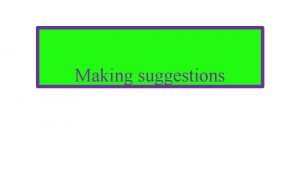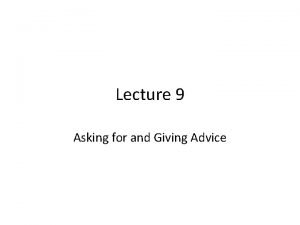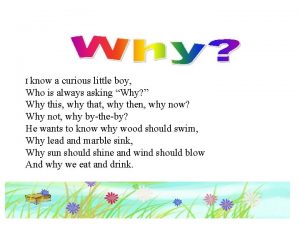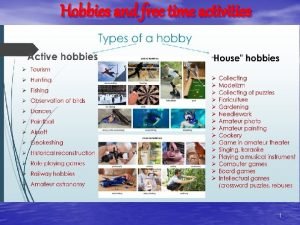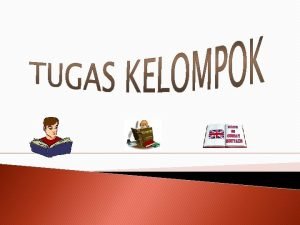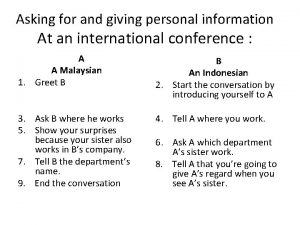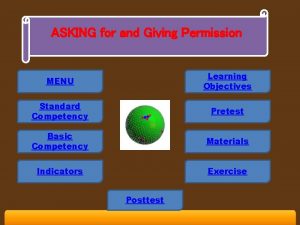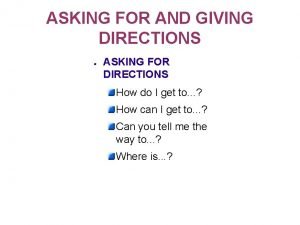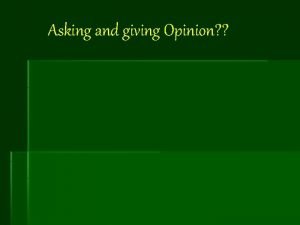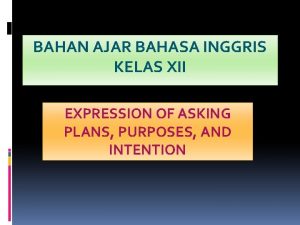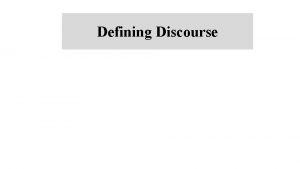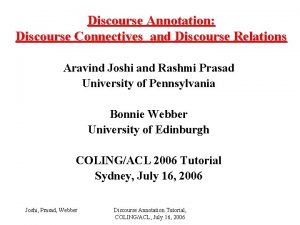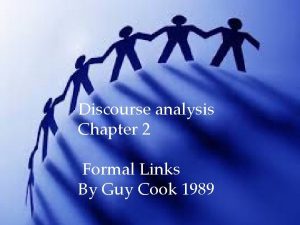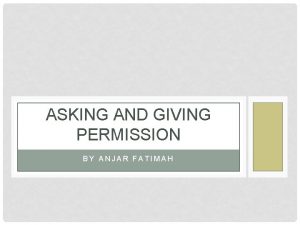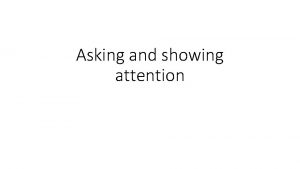Discourse Analysis Discourse Analysis We were asking how






























- Slides: 30

Discourse Analysis

Discourse Analysis We were asking how it is that language-users successfully interpret what other language-users intend to convey. When we carry this investigation further and ask: how we make sense of what we read, how we can recognize well-constructed texts as opposed to those that are jumbled or incoherent, how we understand speakers who communicate more than they say, how we successfully take part in that complex activity called conversation, we are undertaking what is known as discourse analysis.

Definition The word “discourse” is usually defined as “language beyond the sentence” and so the analysis of discourse is typically concerned with the study and interpretation of language in texts and conversation. Ex. : newspaper headline Trains collide, two die.

Discourse Analysis In order to interpret and decode meaning we need to process: Cohesion Coherence Hedges Implicature Background knowledge Schemas and script

Cohesion Texts must have a certain structure that depends on factors quite different from those required in the structure of a single sentence. Some of those factors are described in terms of cohesion, or the ties and connections that exist within texts. My father once bought a Lincoln convertible. He did it by saving every penny he could. That car would be worth a fortune nowadays. However, he sold it to help pay for my college education. Sometimes I think I’d rather have the convertible.

Cohesion Coreferential relations: Repetition: The Prime Minister recorded her thanks to the Foreign Secretary. The Prime Minister was most eloquent. Partial repetition: Dr. E. C. R. Reeve chaired the meeting. Dr. Reeve invited Mr. Philips to report on the state of the gardens. Lexical substituion: Ro’s daughter is ill again. The child is hardly ever well. Jules has a birthday next month. Elspeth has one, too. pronouns: Ro said she would have to take Sophie to the doctor. ellipsis: Jules has a birthday next month. Elspeth has too.

Cohesion Cohesive ties/markers and connectors/connectives: additive: and, or, furthermore, similarly, in addition adversative: but, however, on the other hand nevertheless causal: so, consequently, for this reason, it follows from this time: then, after that, an hour later, finally, at last

Coherence The key to the concept of coherence is not something that exists in words or structures, but something that exists in people. It is people who “make sense” of what they read and hear. People try to arrive at an interpretation that is in line with their experience of the way the world is. Our ability to make sense of what we read/hear is probably only a small part of that general ability we have to make sense of what we perceive or experience in the world.

Coherence Ex. : My father bought a Lincoln convertible. The car driven by the police was red. That color doesn’t suit her. She consists of three letters. However, a letter isn’t as fast as a telephone call. Cohesion (connections between words) but NOT Coherence (connections between words and how we interpret them according to our ability to make sense)

Hedges Hedges can be defined as words or phrases used to indicate that we’re not really sure that we’re saying is sufficiently correct or complete. We can use sort of or kind of as hedges on the accuracy of our statements, as in descriptions such as The book cover is sort of yellow (rather than It is yellow). Other examples would include the expressions listed below that people sometimes put at the beginning of their conversational contributions. As far as I know …, Now, correct me if I’m wrong, but … I’m not absolutely sure, but …. The difference between saying Jackson is guilty Vs I think it’s possible that Jackson may be guilty. implies that in the first utterance, we will be assumed to have very good evidence for the statement.

Implicature When we try to analyze how hedges work, we usually talk about speakers implying something that is not said. Consider the following example. CAROL: Are you coming to the party tonight? LARA: I’ve got an exam tomorrow. Lara’s answer is not simply a statement about tomorrow’s activities, it contains an implicature (an additional conveyed meaning) concerning tonight’s activities

Background Knowledge It is noticeable that, in order to describe the conversational implicature involved in Lara’s statement, we had to appeal to some background knowledge (about exams, studying and partying) that must be shared by the conversational participants. John was on his way to school last Friday. He was really worried about the math lesson. How many interpretations can we have of this two utterances? What kind of background knowledge do we activate?

Schemas and Scripts Background knowledge is built on Schemas and Scripts A schema is a general term for a conventional knowledge structure that exists in memory. We were using our conventional knowledge of what a school classroom is like, or a “classroom schema, ” as in the above example. A script is essentially a dynamic schema. That is, instead of the set of typical fixed features in a schema, a script has a series of conventional actions that take place.

Schemas and Scripts Ex. : Trying not to be out of the office for long, Suzy went into the nearest place, sat down and ordered an avocado sandwich. It was quite crowded, but the service was fast, so she left a good tip. Back in the office, things were not going well. ‘Eating in a restaurant’ schema Vs ‘Eating in a restaurant’ script

Conversation Analysis English conversation can be described as an activity in which, for the most part, two or more people take turns at speaking. Typically, only one person speaks at a time and there tends to be an avoidance of silence between speaking turns. This is not true in all situations or societies.

Conversation Analysis There are different expectations of conversational style and different strategies of participation in conversation. The participants characterized as “rude” or “shy” in this way may simply be adhering to slightly different conventions of turn-taking. In fact, one of the most noticeable features of conversational discourse is that it is generally very “co-operative. ” This observation has been formulated as a principle of conversation.

The Co-operative Principle The co-operative principle is stated in the following way: “Make your conversational contribution such as is required, at the stage at which it occurs, by the accepted purpose or direction of the talk exchange in which you are engaged” (Grice, 1975: 45).

4 Maxims The Quantity maxim: Make your contribution as informative as is required, but not more, or less, than is required. The Quality maxim: Do not say that which you believe to be false or for which you lack adequate evidence. The Relation maxim: Be relevant. The Manner maxim: Be clear, brief and orderly.

Critical Discourse Analysis Brian Paltridge describes CDA as follows: “Critical discourse analysis explores the connections between the use of language and the social and political contexts in which it occurs. It explores issues such as gender, ethnicity, cultural difference, ideology and identity and how these are both constructed and reflected in texts. It also investigates ways in which language constructs and is constructed by social relationships” (2006: 179).

British newspaper the Sun (February 2, 1989) BRITAIN INVADED BY ARMY OF ILLEGALS Britain is being swamped by a tide of illegal immigrants so desperate for a job that they will work for a pittance in our restaurants, cafés and nightclubs. Immigration officers are being overwhelmed with work. Last year, 2191 “illegals” were nabbed and sent back home. But there were tens of thousands more, slaving behind bars, cleaning hotel rooms and working in kitchens … Illegals sneak in by: * DECEIVING immigration officers when they are quizzed at airports * DISAPPEARING after their entry visas run out * FORGING work permits and other documents * RUNNING AWAY from immigration detention centres

Vs BRITAIN HAS A CROWD OF IMMIGRANTS Britain is being overflowed by a tide of illegal immigrants so desperate for a job that they will work for a low salary in our restaurants, cafés and nightclubs. Immigration officers are being overwhelmed with work. Last year, 2191 “illegals” were grapped and sent back home. But there were tens of thousands more, working for bars, cleaning hotel rooms and working in kitchens … Illegals generally use strategies such as: * GIVING false answers to immigration officers when they are quizzed at airports * DISAPPEARING after their entry visas run out * CHANGING work permits and other documents * RUNNING AWAY from immigration detention centres

Analysis Two metaphors (invading army and tide) to create a negative and frightening view of these immigrants. The use of vague high numbers (tens of thousands) adds to this frightening perspective. Dishonest and criminal behavior is attributed to the immigrants through the verbs sneak, deceive, forge and run away. Other observations can be made relating to existing power structures (no mention is made of the employers who must be benefiting from the situation) and ideology (what does the image of Britain being invaded by an army suggest? )

Critical Discourse Analysis E. g. : Rhodesia Herald wrote in 1975, ‘A political clash has led to death and injury’, while the Tanzanian Daily News wrote, ‘Rhodesia’s white suprematist police. . . opened fire and killed thirteen unarmed Africans. ’


Hedging and persuasion Using would could or might to make what you say more tentative Ex. : 1. 2. That is unacceptable > That would be unacceptable We need further reassurance > We would need further reassurance

Hedging and persuasion Using a grammatical negative (adding not) to make a suggestion more open and therefore more negotiable Ex. : 1. Wouldn’t you agree that…. . ? 2. Wouldn’t it be a good idea to…. ?

Hedging and persuasion There are some phrases which warn the listener/reader that disagreement follows. These are the most common introductory phrases or cohesive ties and connectors: Actually, Well, Frankly, With respect, To be honest, As a matter of fact, In those circumstances, In fact.

Hedging and persuasion Using not with a positive word instead of the obvious negative word. Ex. : 1. It is inconvenient > It is not very convenient 2. I disagree > I do not agree 3. This year’s figures are bad > This year’s figures are not so good

Hedging and persuasion The more general the statement, the more unlikely it is to produce disagreement. Restrict general statement to make your position more flexible by using qualifiers: Ex. : a slight misunderstanding, a little bit too early, some reservations, a short delay, a bit of a problem, a little more time.

Hedging and persuasion Using a comparative to soften your message and to be more tactful. Ex. : 1. It is appropriate to wait a few weeks > It would be more appropriate to wait a few weeks. 2. The World Bank is anxious to support this kind of project > The World Bank might be more anxious to support this kind of project
 What is discourse and discourse analysis
What is discourse and discourse analysis Content vs discourse analysis
Content vs discourse analysis Was/were going to
Was/were going to Formal email requesting information
Formal email requesting information Letter asking for information
Letter asking for information Make or give suggestions
Make or give suggestions Enquiry letter for admission in college
Enquiry letter for admission in college Asking for and giving advice
Asking for and giving advice What are rocking numbers in asl
What are rocking numbers in asl I know a curious little boy poem
I know a curious little boy poem What did you do in your free time
What did you do in your free time Doni i'm thinking of asking you for dinner
Doni i'm thinking of asking you for dinner Mind mapping asking and giving opinion
Mind mapping asking and giving opinion Essential question definition
Essential question definition Asking personal information
Asking personal information Tell past events
Tell past events Giving permission
Giving permission Listen to the dialogue and fill in the gaps
Listen to the dialogue and fill in the gaps Asking for and giving advice
Asking for and giving advice Asking for an opinion example
Asking for an opinion example Asking and giving opinion about bullying
Asking and giving opinion about bullying 7-eleven
7-eleven Asking for help expression
Asking for help expression Taking something that doesn't belong to you
Taking something that doesn't belong to you Intonation question tags
Intonation question tags Present continuous exercises
Present continuous exercises Giving and asking suggestion
Giving and asking suggestion Modul pembelajaran bahasa inggris kelas 12
Modul pembelajaran bahasa inggris kelas 12 Sponge and panning for gold approach
Sponge and panning for gold approach Observing and asking questions
Observing and asking questions Shall asking for permission
Shall asking for permission





